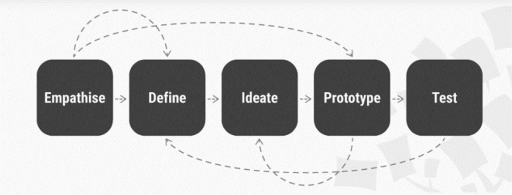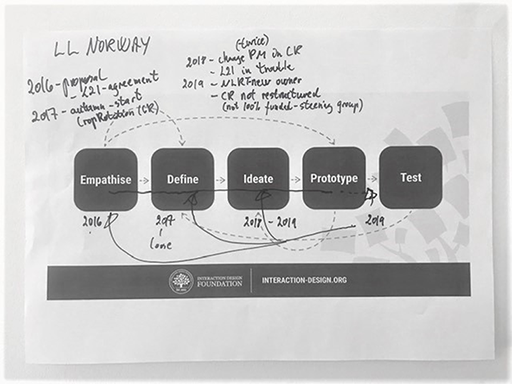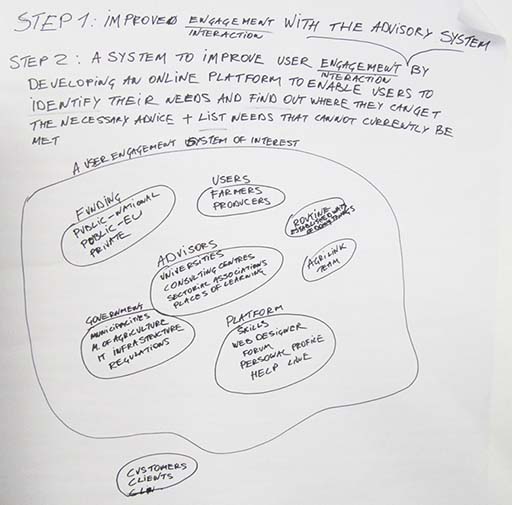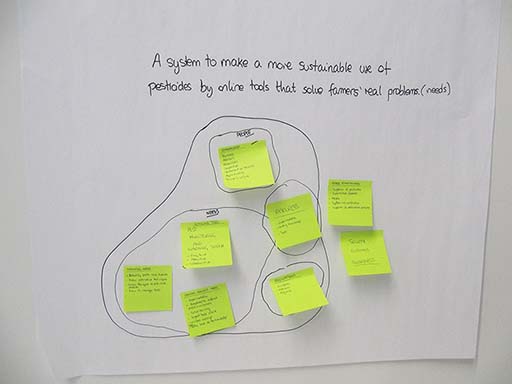Use 'Print preview' to check the number of pages and printer settings.
Print functionality varies between browsers.
Printable page generated Friday, 26 April 2024, 6:30 PM
Session 4 The multi-method approach: applying design thinking and systems thinking
Session 4 The multi-method approach: applying design thinking and systems thinking
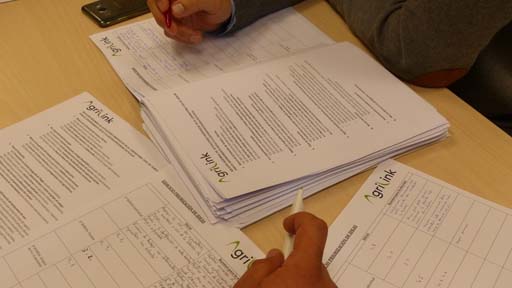
In this fourth session we explore some key methods we employed in our Living Labs. Watch the following video for an overview of two of these before reading further.
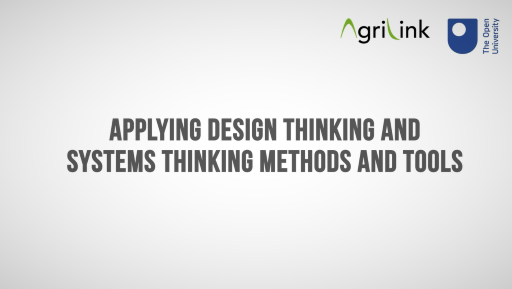
Transcript
HERMAN SCHOORLEMMER:
There are several methods that can be used to involve different stakeholders in the co-creation of innovative advisory services. We found the two widely used approaches provided the tools needed to develop our innovations and to consider the implications of what we did. The first approach is design thinking, which provided an iterative and structured process for developing a solution to a problem.
The second is systems thinking, which help you to look at the boundary of a problem, the connections between elements of the problem and solution, and the perspectives of the different stakeholders. This session explains how we used these two approaches in our six Living Labs.
I briefly explained in Session 3 that there were three conceptual frameworks that we used to guide our actions – design thinking, systems thinking and reflexive monitoring. In each case there is a theoretical underpinning to them, but each is also very much about providing tools and techniques to ensure effective practice in managing complex situations.
In this session I am going to look at the principles of design thinking and systems thinking and leave looking at reflexive monitoring until Session 6 (Session 5 looks at facilitating design thinking and system thinking tools and techniques – that is, putting them into practice).
But it is important to note that these three frameworks have been used in a reflective and complementary way and not simply as a toolbox – although each has provided useful tools and techniques to be used in the Living Labs.
Now go to the next section.
Design thinking
 Reflective Activity 8
Reflective Activity 8
Make notes below on what you think are the main features of design from your knowledge and experience.
The answer you give will depend upon your own knowledge and experiences but equally I have talked about design in certain ways during the course that might influence you. But the main aim of the activity is to get you thinking about a very common process – design – and what makes it useful before I talk about design thinking.
Answer
Designs are the things that design thinking produces – the products of thinking if you like. Almost everything you see around you is designed; that is, it exists as a result of human thought about what is needed. As I sit in my office, I see a telephone, a cup, a building opposite my window, a computer in front of me, the chair I am sitting on and the clothes I am wearing. These are the obvious objects of design.
However, there are less obvious things, too: the software I am using to write this paragraph, the circuit boards in the computer (and the chips on the circuit board), and the way I have organised the sections of this course and gone about using different elements of AgriLink work. So, design involves processes, systems and structures as well as products.
If you ask most people what they think design is, they will probably mention something like the iPhone, something that looks a bit different from other things in the same category and that probably claims to outperform them as well. This is what I call ‘designer design’: things that are produced to showcase design, and which are marketed and written about accordingly. They are things that have been ‘given’ to us by designers, rather than being something we participate in.
Yet there is another side to design that I will call ‘practitioner design’. By this I mean the kind of design that you or I might do to our personal space, or the things that are designed but go unnoticed, such as road markings. Practitioner design is much more prevalent than designer design and impacts almost every aspect of our lives. That is not to say that practitioner design is not designed by professionals, most of the time it is, but sometimes it is not referred to explicitly as design.
We might better describe practitioner design as being the products of everyday design thinking and practices – the processes, systems and structures – that meet our needs and shape our everyday behaviours.
Lawrence Lessig has noticed how designs (he calls them ‘things’) often have a ‘law-like’ character, regulating our behaviour in certain ways. Lessig (1999) describes four ways in which our behaviour is controlled and regulated.
Let us look at the example of parking:
| The first is by the law. It is determined that it is illegal to park in some places, and most people generally observe this law. If they break this law, and are observed to have done so, they are penalised. |
| The second is by norms. In places where people do park, they observe an unofficial code – ‘leave a bit of distance between the car you are parking next to’, or ‘do not block someone else's exit’. |
| The third is by the market. Whether you can afford to park affects your ability to park. So, if the market determines a price that you cannot afford (or refuse to pay), then you will look for somewhere else to park. |
| The final way is by architecture (what we can think of as design). A few painted lines on a piece of tarmac mean that we all park in a certain orientation, because the architecture ‘tells’ us to. |
If the product of design thinking is something that is able to improve our lives and shape our behaviour, it self-evidently originates from, and involves, people. In contrast to an activity like art, which often (though certainly not always) involves only one person in its production, design usually involves several people in several different roles. Design, then, is something that is inherently social or, put another way, something that creates social or cultural value. Of course, this value can come in a lot of different forms: ease and effectiveness of use, economic value, aesthetic value, functionality, meaningfulness – all these things and more contribute to the way in which design creates value.
Let us think about the number of people that might be involved in design. First, we have the designer themselves. For the moment we can assume that they are at the fulcrum of a design process. But perhaps there is more than one designer? The designer, or team of designers, is usually working on behalf of someone: the person we normally call the client. The client is the person or persons who have an ‘unfulfilled need’; they have a problem that needs solving and are usually prepared to pay to have it solved. The solution to their problem will often involve other groups of people. The role that these types of people play – designer, client and user – can often overlap and be the same person. Generally, however, these will be different people or groups of people.
In the past, the role of the designer was reasonably clear; the designer was the person who came up with the ideas and presented them to the client, who then chose the one they liked best. Designers also tended to stick to specific disciplines: graphic designers concentrated on graphics, architects on buildings, fashion designers on clothing, and product designers on products. In the past few years, though, a different kind of designer has emerged. This is a person or persons who can bring together expertise to tackle more complicated problems, not necessarily problems that can easily be solved by just one discipline. This is a person or persons who can ‘organise’ a solution by using several methods. These are the type of people needed at the heart of Living Lab. But equally such people who ‘facilitate’ the design process to create an innovative solution to a need or problem also need frameworks to guide their work – which is where models of design thinking come in.
In his 1969 seminal text on design methods, The Sciences of the Artificial, Nobel Prize laureate Herbert Simon (1969) outlined one of the first formal models of the design thinking process. Simon’s model consists of seven major stages, each with component stages and activities, and was largely influential in shaping some of the most widely used design thinking process models today. These seven steps are Define, Research, Ideate, Prototype, Choose, Implement and Learn.
There are many variants of the design thinking process in use today, and while they may have different numbers of stages ranging from three to seven, they are all based upon the same principles featured in Simon’s 1969 model. A brief history of design thinking can be found hereon the Interaction Design Foundation website. In AgriLink, we used a five-stage model, Empathise, Define (the problem), Ideate, Prototype and Test, that is promoted by the Interaction Design Foundation (Figure 4.1).
Design thinking is a method for practical, creative resolution of problems. It is a form of solution-based thinking with the intent of producing a constructive future result. Design thinking is especially useful when addressing wicked problems, which are ill-defined or tricky. With ill-defined problems, both the problem and the solution are unknown at the outset of the problem-solving exercise.
The five steps of design thinking (Figure 4.1) are:
| Empathise: gain an empathic understanding of the problem through observing, engaging and empathising with people to understand their experiences and motivations |
| Define: analyse observations and define the problem in a human-centred manner |
| Ideate: generating ideas |
| Prototype: production of an inexpensive, scaled-down version of the product useful to investigate the problem solution |
| Test: the complete product using the best solutions identified during the prototyping phase. Results of the test can be used to redefine one or more problems and result in an iterative process. |
While there is a linear sequence from empathise to test, Figure 4.1 also makes clear there are feedback loops where iteration is necessary between stages as understanding and insights develop, and as can be seen in Figure 4.2 which shows a review of the steps and timings involved in the Norwegian Living Lab.
Due to this non-linearity and iteration, it can help to represent the five steps as a circular process (Figure 4.3).
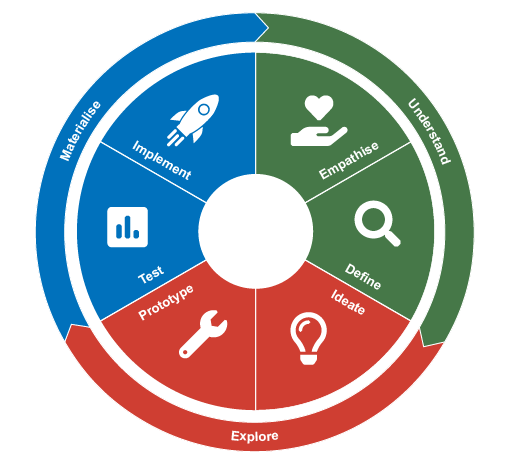
In the Living Labs, we went through these five steps together with a core group of stakeholders. In each step we made use of the process tools and experiences of project partners to improve the articulation of motives and demands and to generate creative solutions and ideas. We also want to stress again that although in Figure 4.1 the approach is presented as a linear process and in Figure 4.3 a circular process, in reality it evolves in a more flexible and non-linear fashion with divergent and convergent parts to each step and iteration through the steps as a result of changes in technology or legislation as indicated in Figure 4.2.
For example, the development of a prototype can lead to an improved understanding of the problem or lead to a new brainstorming session. In reality, there are many potential obstacles to creating a good design thinking process. For example, empathy can seem simple to do, but if the need is unclear, problems can arise during prototyping, and so take time to clarify the needs – within the AgriLink Living Labs there were sessions with groups of farmers.
Choosing appropriate tools and techniques can be crucial – within AgriLink we used the GPS method for brainstorming which allows people to think individually and in a group (there is much more on the tools and techniques we used in later sessions and in the toolbox guide). Also, the intensity of co-creation, cooperation with the farmer and other stakeholders is not the same at every stage and depends on the specific context.
Indeed, important to the development of the Living Labs and scaling of lessons and experiences was to go about our processes systemically whereby we were continually contextualising what we were doing, recognising our influences and what we were affecting as we went along. The techniques (and skills) of systems thinking and in particular systems diagramming proved very helpful.
Systems thinking
 Reflective Activity 9
Reflective Activity 9
Make notes below on what you think are the main features of systems thinking.
This is not a test question. There are no right or wrong answers. I am simply inviting you to explore what you already understand about systems thinking.
If you have already studied systems thinking, you may find this task quite demanding because you will have to abstract these general ideas from what may be quite detailed understandings. If your only experience of systems thinking is through any background reading you may have done, you may want to base your answers directly on your recent reading. That is fine, but try to ensure that, in doing this activity, you are building your understanding and not just abstracting a list from someone else's ideas.
If systems thinking is totally new to you, try and capture what has already been said about systems and systems thinking in the course so far.
Answer
You should not treat this as the ‘right’ answer. My notes arise from my experiences, yours arise from your own. I would like to think you and I were both engaged in an activity that gives rise to new experiences and thus builds our own understandings from our own experiences.
The important features of systems thinking, as I see them, are these:
Systems thinking attends to the connections between things, events and ideas. It gives them equal status with the things, events and ideas themselves. So, systems thinking is fundamentally about relationship and process, a framework for understanding inter-relationships. It is often the relationships between things, events and ideas that give them their meaning. This attention to relationships between things, events and ideas means I can observe patterns of connection that give rise to larger wholes. This gives rise to emergence. Thinking systemically about these connections includes being open to recognising that the patterns of connection are more often web-like than linear chains of connection.
Systems thinking respects complexity, it does not pretend it is not there. This means, among other things, I accept that sometimes my understanding is incomplete. It means when I experience a situation or an issue as complex, I do not always know what is included in the issue and what is not. It means I have to accept my view is partial and provisional and other people will have a different view. It means I resist the temptation to try and simplify the issue by breaking it down. It also means I have to accept there is more than one way of understanding the complexity. Systems thinking allows me to let go of this notion of one way of understanding and allows me to use a multiplicity of interpretations and models to form views and ideas about the complexity, how to comprehend it, and how to act purposefully within it. Essentially, it is about using practical frameworks for engaging with multiple perspectives.
Systems thinking makes complexity manageable by taking a broader perspective. When I was studying science as an undergraduate, we were taught to break down situations into their component parts. This approach is so deeply entrenched in western culture it seems natural and obvious to anyone brought up or educated in this culture that this is the way to tackle complex situations. Systems thinking characteristically moves one's focus in the opposite direction, working towards understanding the big picture – the context – as a way of making complexity understandable.
Most people recognise they have been in situations where they ‘can't see the wood for the trees’. Systems thinking is precisely about changing the focus of attention to the wood, so that you can see the trees in their context. Understanding the woodland gives new and powerful insights about the trees and indeed all the other elements in the wood that interact with the trees (topography, soil, water, sunlight, flora and fauna, to name just a few). Such insights are completely inaccessible if one concentrates on the individual trees.
In other words, systems thinking provides a framework for reflecting on boundary judgements, of what to include and what not to include in my system of interest.
Other people will and do set out a different set of features as there are many varieties of systems thinking but these are the features that have been used within AgriLink’s Living Labs.
Systems and complexity in agriculture
It is one thing to know about some of the principles of systems thinking, but how have these been applied to agriculture? I (Andy Lane) set this out in AgriLink Practice Abstract 12 on Systems and complexity in agriculture:
‘Systems’ and ‘complexity’ are both everyday terms, but they also have a more specific meaning within research and development on complex situations such as agriculture. Systems thinking in practice is a way of thinking about and acting in the world through the use of holistic representations of what we, individually and/or collectively, perceive about situations, such as relationships between farmers, advisors and research organisations. Systems thinking largely views complexity as being a mix of rational and emotional responses to messy situations.
In contrast, complexity science often uses quantitative models to represent large, rational, non-linear, dynamical systems that exhibit unpredictable behaviours. Agricultural policies and practices are shaped by histories and traditions. Some policies and practices are developed through trial and error and not always formally recorded, while some are based on experiments and structured scientific observations and systematically recorded in reports and journal articles. Systems thinking in practice complements the scientific approach by looking at policies and practices in their contexts in order to understand them, by recognising important connections between people, events and ideas, and by taking account of multiple perspectives.
One way to do this is for stakeholders to co-develop diagrams involving words, images, symbols and lines to represent multiple perspectives on systems of interest. In the making of such joint diagrams, differing viewpoints can emerge, conflicts can be discussed and the expert knowledge of different members can be harnessed.
More information on this topic can be found in this AgriLink Theory Primer on Systems and Complexity.
Visual representations as aids to thinking
I mention above that co-developing diagrams can be one way to help design and deliver innovative advisory services. The use of visual representations has been mentioned a number of times in this course and we have also used various diagrams to help explain aspects of AgriLink work. This reason for using visual representations in our Living Lab work is explained further through my (Andy Lane) AgriLink Practice Abstract on Using diagrams to help design and deliver Living Labs:
The Living Lab concept is an inquiry process that builds on the principles of design thinking, systems thinking and reflexive monitoring. Design thinking helps to frame the development process. With systems thinking in practice, the process is extended through a process of co-creation with Living Lab partners that involves understanding contexts, inter-relationships, engaging with multiple perspectives and reflecting on boundary judgements.
Consequently, each Lab is unique. Each Lab must be observed, understood, and ‘tailor-made’ interventions must be designed and developed in conjunction with its many participants and stakeholders. This uniqueness also requires reflexive monitoring, where the performance of the Lab is regularly reviewed by participants and stakeholders, and learnings identified and acted upon. Design thinking, systems thinking and reflexive monitoring can all benefit from the use of diagrams or other visual representations as communicative devices, as can all stages in the inquiry process.
In some cases, this can be a diagram produced by one or more participants for others to comment on, but more often these are diagrams produced collectively on large sheets of paper by groups of participants working together. Thus, diagrams can help frame and focus the discussion. Co-creating it in real time enables everyone to contribute, while the final version provides an unfiltered record of the discussion at that point in time, which can be reviewed or referred to at a later stage in the development of the Living Lab.
In that sense, most of these diagrams are works in progress for co-learning about and testing out ideas and proposals rather than a finalised output, although redrawn versions might be produced for more formal documents (see Figure 4.3).
Using systems diagrams
There are many types of diagram and many ways in which they can be used, but it will take up too much time to explain all of the ins and outs of using diagrams as part of systems thinking in practice in this course.
We shall see some more examples of the ones we used in our Living Labs in Session 5, and these types are also explained further in the section on representing your situations with diagrams in the accompanying AgriLink Living Lab Toolbox.
Helpfully, there are other free courses from The Open University that do. So, if you do want to find out more about them, then you will need to look either at Systems diagramming or Week 4 on Representing systems of interest in Mastering systems thinking in practice.
Summary of Session 4
In this session I have explained how we have drawn upon the ideas of design thinking and of systems thinking within AgriLink.
In particular, we have used a five-step model of design thinking and systems diagrams as tools or techniques to address the specific agricultural advisory services that investigated in each of our six Living Labs.
But we also used these tools or techniques in ways that respected the underlying philosophy of these ways of thinking.
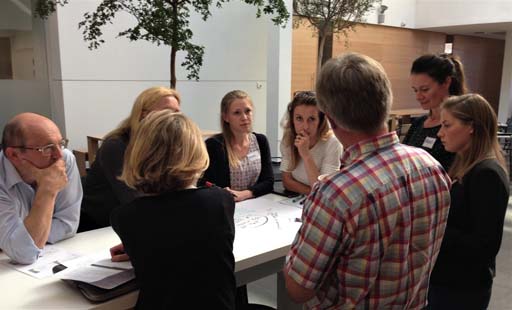
References for Session 4
Bootcamp Bootleg D.School. (2010) Modes of design thinking. D.School, University of Stanford. Available at: https://dschool.stanford.edu/ s/ METHODCARDS-v3-slim.pdf (Accessed 9 February 2021).
Dam, R.F. and Siang, T.Y. (2020) ‘5 Stages in the Design Thinking Process’, Interaction Design. Available at: https://www.interaction-design.org/ literature/ article/ 5-stages-in-the-design-thinking-process (Accessed 9 February 2021).
Lessig, L. (1999) Code and Other Laws in Cyberspace, Basic Books.
Simon, H.A. (1969) The Sciences of the Artificial. 1st Edition, MIT Press, Cambridge, Massachusetts.
